A Comprehensive Overview of Heritage BIM Frameworks: Platforms and Technologies Integrating Multi-Scale Analyses, Data Repositories, and Sensor Systems
Abstract
1. Introduction
2. Materials and Methods
2.1. Literature Identification and Screening
- Modeling methodologies based on semi-automatic or automatic processes from photogrammetric or laser scanning data (e.g., SCAN-to-BIM), or based on generative geometry techniques, when these were not embedded within integrated workflows that connect HBIM to other data or systems;
- Ontologies, libraries, and HBIM-specific procedures (e.g., CIDOC CRM, IfcOWL, HiCO, ArCo, CityGML) that were addressed exclusively from a theoretical standpoint, without adequate evidence of implementation strategies, validation efforts, or contextualization within operative workflows or heritage-related use cases;
- Integration of documentary, experimental, and analytical data (e.g., FEM analyses or energy simulation tools within HBIM), when lacking methodological clarity regarding data alignment, workflow integration, or the interoperability between platforms;
- Visualization or reporting implementations (e.g., 3D models, digital dashboards) when these were not part of a broader interoperable framework or did not support collaborative or analytical functionalities beyond mere representation.
- Data exchange (e.g., standardized communication protocols such as IFC, XML, JSON), facilitating interoperability and synchronized data transfer across heterogeneous platforms within validated workflows;
- System integration (e.g., end-to-end workflows or collaborative interfaces linking databases, analytical tools, and visualization platforms), enabling interconnected software environments without modifying core software logic, thereby supporting multidisciplinary coordination and centralized heritage data management;
- Cross-content processing (e.g., computational methods such as semantic enrichment, machine learning, or automated transformation scripts), implementing data analysis and transformation across HBIM and allied systems to improve analytical precision, operational efficiency, or workflow automation in heritage-related contexts.
2.2. Bibliometric Evaluation
3. Results and Discussion
3.1. RQ1: What Are the Main Thematic Areas in Which HBIM-Related IDPs Are Developed?
3.1.1. RQ1 in T1: Multi-Scale Analyses Through HBIM-GIS Integration
3.1.2. RQ1 in T2: Development of Multi-Source Data Repositories in HBIM
3.1.3. RQ1 in T3: Integration and Management of Sensor Systems Within HBIM
3.2. RQ2: What Are the Main Application Fields and Purposes in Which HBIM-Related IDPs Are Applied?
3.2.1. RQ2 in T1
3.2.2. RQ2 in T2
3.2.3. RQ2 in T3
3.3. RQ3: What Are the Frameworks/Tools/Technologies Enabling HBIM-Related IDPs?
3.3.1. RQ3 in T1
3.3.2. RQ3 in T2
3.3.3. RQ3 in T3
4. Conclusions and Future Perspectives
Author Contributions
Funding
Data Availability Statement
Acknowledgments
Conflicts of Interest
Abbreviations
| CIDOC-CRM | Conceptual Reference Model |
| CH | Cultural heritage |
| GIS | Geographic information systems |
| HBIM | Historic/Heritage Building Information Modeling |
| IDPs | Integrated digital platforms |
| IFC | Industry Foundation Classes |
| IoT | Internet of Things |
| LoDs | Levels of Detail |
| LODs | Levels of Development |
| TNA | Thrust Network Analysis |
| XR | Extended reality |
References
- Murphy, M.; McGovern, E.; Pavia, S. Historic Building Information Modelling (HBIM). Struct. Surv. 2009, 27, 311–327. [Google Scholar] [CrossRef]
- Giuliani, F.; Gaglio, F.; Martino, M.; De Falco, A. A HBIM Pipeline for the Conservation of Large-Scale Architectural Heritage: The City Walls of Pisa. Herit. Sci. 2024, 12, 35. [Google Scholar] [CrossRef]
- Buldo, M.; Agustin-Hernandez, L.; Verdoscia, C.; Tavolare, R. A Scan-To-Bim Workflow Proposal for Cultural Heritage. Automatic Point Cloud Segmentation and Parametric-Adaptive Modelling of Vaulted Systems. Int. Arch. Photogramm. Remote Sens. Spat. Inf. Sci. 2023, 48, 333–340. [Google Scholar] [CrossRef]
- Moyano, J.; León, J.; Nieto-Julián, J.E.; Bruno, S. Semantic Interpretation of Architectural and Archaeological Geometries: Point Cloud Segmentation for HBIM Parameterisation. Autom. Constr. 2021, 130, 103856. [Google Scholar] [CrossRef]
- Currà, E.; D’amico, A.; Angelosanti, M. HBIM between Antiquity and Industrial Archaeology: Former Segrè Papermill and Sanctuary of Hercules in Tivoli. Sustainability 2022, 14, 1329. [Google Scholar] [CrossRef]
- Bruno, S.; Antonella, M.; Fabio, F.; Dell’Osso, G.R. The Role of 4D Historic Building Information Modelling and Management in the Analysis of Constructive Evolution and Decay Condition within the Refurbishment Process. Int. J. Archit. Herit. 2021, 15, 1250–1266. [Google Scholar] [CrossRef]
- Jordan-Palomar, I.; Tzortzopoulos, P.; García-Valldecabres, J.; Pellicer, E. Protocol to Manage Heritage-Building Interventions Using Heritage Building Information Modelling (HBIM). Sustainability 2018, 10, 908. [Google Scholar] [CrossRef]
- Nieto-Julián, E.; Bruno, S.; Moyano, J. An Efficient Process for the Management of the Deterioration and Conservation of Architectural Heritage: The HBIM Project of the Duomo of Molfetta (Italy). Remote Sens. 2024, 16, 4542. [Google Scholar] [CrossRef]
- Massafra, A.; Davide, P.; Gulli, R. Reverse Engineering Workflows for the Structural Assessment of Historical Buildings. Int. J. Archit. Herit. 2025, 19, 702–723. [Google Scholar] [CrossRef]
- Bruno, S.; de Fino, M. Decision-Making for Historic Building Diagnosis by Logical Inference in HBIM Approach: The Case of Onsite Inspection of Timber Elements. SCIRES-IT 2021, 11, 67–82. [Google Scholar] [CrossRef]
- Penjor, T.; Banihashemi, S.; Hajirasouli, A.; Golzad, H. Heritage Building Information Modeling (HBIM) for Heritage Conservation: Framework of Challenges, Gaps, and Existing Limitations of HBIM. Digit. Appl. Archaeol. Cult. Herit. 2024, 35, e00366. [Google Scholar] [CrossRef]
- Pocobelli, D.P.; Boehm, J.; Bryan, P.; Still, J.; Grau-Bové, J. BIM for Heritage Science: A Review. Herit. Sci. 2018, 6, 30. [Google Scholar] [CrossRef]
- López, F.J.; Lerones, P.M.; Llamas, J.; Gómez-García-Bermejo, J.; Zalama, E. A Review of Heritage Building Information Modeling (H-BIM). Multimodal Technol. Interact. 2018, 2, 21. [Google Scholar] [CrossRef]
- Ávila, F.; Blanca-Hoyos, Á.; Puertas, E.; Gallego, R. HBIM: Background, Current Trends, and Future Prospects. Appl. Sci. 2024, 14, 11191. [Google Scholar] [CrossRef]
- Yang, X.; Grussenmeyer, P.; Koehl, M.; Macher, H.; Murtiyoso, A.; Landes, T. Review of Built Heritage Modelling: Integration of HBIM and Other Information Techniques. J. Cult. Herit. 2020, 46, 350–360. [Google Scholar] [CrossRef]
- Lovell, L.J.; Davies, R.J.; Hunt, D.V.L. The Application of Historic Building Information Modelling (HBIM) to Cultural Heritage: A Review. Heritage 2023, 6, 6691–6717. [Google Scholar] [CrossRef]
- Diara, F. HBIM Open Source: A Review. ISPRS Int. J. Geo-Inf. 2022, 11, 472. [Google Scholar] [CrossRef]
- Scianna, A.; Gaglio, G.F.; La Guardia, M. HBIM Data Management in Historical and Archaeological Buildings. Archeol. Calc. 2021, 31, 231–252. [Google Scholar]
- Baarimah, A.O.; Alaloul, W.S.; Liew, M.S.; Kartika, W.; Al-Sharafi, M.A.; Musarat, M.A.; Alawag, A.M.; Qureshi, A.H. A Bibliometric Analysis and Review of Building Information Modelling for Post-Disaster Reconstruction. Sustainability 2022, 14, 393. [Google Scholar] [CrossRef]
- Puerto, A.; Castañeda, K.; Sánchez, O.; Peña, C.A.; Gutiérrez, L.; Sáenz, P. Building Information Modeling and Complementary Technologies in Heritage Buildings: A Bibliometric Analysis. Results Eng. 2024, 22, 102192. [Google Scholar] [CrossRef]
- Munn, Z.; Peters, M.D.J.; Stern, C.; Tufanaru, C.; McArthur, A.; Aromataris, E. Systematic Review or Scoping Review? Guidance for Authors When Choosing between a Systematic or Scoping Review Approach. BMC Med. Res. Methodol. 2018, 18, 143. [Google Scholar] [CrossRef]
- Page, M.J.; McKenzie, J.E.; Bossuyt, P.M.; Boutron, I.; Hoffmann, T.C.; Mulrow, C.D.; Shamseer, L.; Tetzlaff, J.M.; Akl, E.A.; Brennan, S.E.; et al. The PRISMA 2020 Statement: An Updated Guideline for Reporting Systematic Reviews. Syst. Rev. 2021, 10, 89. [Google Scholar] [CrossRef]
- Manzoor, B.; Othman, I.; Pomares, J.C. Digital Technologies in the Architecture, Engineering and Construction (Aec) Industry—A Bibliometric—Qualitative Literature Review of Research Activities. Int. J. Environ. Res. Public Health 2021, 18, 6135. [Google Scholar] [CrossRef]
- Brozovsky, J.; Labonnote, N.; Vigren, O. Digital Technologies in Architecture, Engineering, and Construction. Autom. Constr. 2024, 158, 105212. [Google Scholar] [CrossRef]
- Almusaed, A.; Yitmen, I.; Almssad, A. Reviewing and Integrating AEC Practices into Industry 6.0: Strategies for Smart and Sustainable Future-Built Environments. Sustainability 2023, 15, 13464. [Google Scholar] [CrossRef]
- Darko, A.; Chan, A.P.C.; Adabre, M.A.; Edwards, D.J.; Hosseini, M.R.; Ameyaw, E.E. Artificial Intelligence in the AEC Industry: Scientometric Analysis and Visualization of Research Activities. Autom. Constr. 2020, 112, 103081. [Google Scholar] [CrossRef]
- Donthu, N.; Kumar, S.; Mukherjee, D.; Pandey, N.; Lim, W.M. How to Conduct a Bibliometric Analysis: An Overview and Guidelines. J. Bus. Res. 2021, 133, 285–296. [Google Scholar] [CrossRef]
- Sammartano, G.; Avena, M.; Fillia, E.; Spanò, A. Integrated HBIM-GIS Models for Multi-Scale Seismic Vulnerability Assessment of Historical Buildings. Remote Sens. 2023, 15, 833. [Google Scholar] [CrossRef]
- Avena, M.; Colucci, E.; Sammartano, G.; Spanò, A. HBIM Modelling for an Historical Urban Centre. Int. Arch. Photogramm. Remote Sens. Spat. Inf. Sci. 2021, 43, 831–838. [Google Scholar] [CrossRef]
- Colucci, E.; de Ruvo, V.; Lingua, A.; Matrone, F.; Rizzo, G. HBIM-GIS Integration: From IFC to CityGML Standard for Damaged Cultural Heritage in a Multiscale 3D GIS. Appl. Sci. 2020, 10, 1356. [Google Scholar] [CrossRef]
- Barazzetti, L. Integration Between Building Information Modeling And Geographic Information System for Historic Buildings And Sites: Historic-Bim-Gis. ISPRS Ann. Photogramm. Remote Sens. Spat. Inf. Sci. 2021, 8, 41–48. [Google Scholar] [CrossRef]
- Colucci, E.; Iacono, E.; Matrone, F.; Ventura, G.M. The Development of a 2d/3d Bim-Gis Web Platform for Planned Maintenance of Built and Cultural Heritage: The Main10ance Project. Int. Arch. Photogramm. Remote Sens. Spat. Inf. Sci. 2023, 48, 433–439. [Google Scholar] [CrossRef]
- Rechichi, F. Chimera: A BIM+GIS System for Cultural Heritage. Int. Arch. Photogramm. Remote Sens. Spat. Inf. Sci. 2020, 43, 493–500. [Google Scholar] [CrossRef]
- Radanovic, M.; Khoshelham, K.; Fraser, C. A Platform for Multilayered Documentation of Cultural Heritage. ISPRS Ann. Photogramm. Remote Sens. Spat. Inf. Sci. 2021, 5, 9–15. [Google Scholar] [CrossRef]
- Delpozzo, E.; Balletti, C. Bridging the Gap: An Open-Source Gis+bim System for Archaeological Data.The Case Study of Altinum, Italy. Int. Arch. Photogramm. Remote Sens. Spat. Inf. Sci. 2023, 48, 491–498. [Google Scholar] [CrossRef]
- D’Urso, M.G.; Aldrighettoni, J. Geodatabase, Metric Reconstruction and a GIS Platform of Historical-Archaeological Sites in Aquino. Acta IMEKO 2024, 13, 3. [Google Scholar] [CrossRef]
- Barrile, V.; Genovese, E. Gis-like Environments and Hbim Integration for Ancient Villages Management and Dissemination. Int. Arch. Photogramm. Remote Sens. Spat. Inf. Sci. 2024, 48, 41–47. [Google Scholar] [CrossRef]
- Garcia-Valldecabres, J.L.; Liu, J.; Willkens, D.S.; Escudero, P.A.; Lopez-Gonzalez, C.; Cortes Meseguer, L.; Orozco Carpio, P.R. Development of a Virtual Itinerary with Hbim and Gis. Int. Arch. Photogramm. Remote Sens. Spat. Inf. Sci. 2023, 48, 645–652. [Google Scholar] [CrossRef]
- Tzima, M.S.; Agapiou, A.; Lysandrou, V.; Artopoulos, G.; Fokaides, P.; Chrysostomou, C. An Application of Machine Learning Algorithms by Synergetic Use of SAR and Optical Data for Monitoring Historic Clusters in Cypriot Cities. Energies 2023, 16, 3461. [Google Scholar] [CrossRef]
- Gigliarelli, E.; Calcerano, F.; Cessari, L. Heritage Bim, Numerical Simulation and Decision Support Systems: An Integrated Approach for Historical Buildings Retrofit. Energy Procedia 2017, 133, 135–144. [Google Scholar] [CrossRef]
- López-González, C.; García-Valldecabres, J. The Integration of HBIM-SIG in the Development of a Virtual Itinerary in a Historical Centre. Sustainability 2023, 15, 13931. [Google Scholar] [CrossRef]
- Baik, A.; Yaagoubi, R.; Boehm, J. Integration of Jeddah Historical Bim and 3D GIS for Documentation and Restoration of Historical Monument. Int. Arch. Photogramm. Remote Sens. Spat. Inf. Sci. 2015, 40, 29–34. [Google Scholar] [CrossRef]
- Pepe, M.; Costantino, D.; Alfio, V.S.; Restuccia, A.G.; Papalino, N.M. Scan to BIM for the Digital Management and Representation in 3D GIS Environment of Cultural Heritage Site. J. Cult. Herit. 2021, 50, 115–125. [Google Scholar] [CrossRef]
- Meseguer, L.C.; Valldecabres, J.G. Digital Twins. HBIM Information Repositories to Centralize Knowledge and Interdisciplinary Management of Architectural Heritage. Vitruvio 2023, 8, 64–75. [Google Scholar] [CrossRef]
- Galeazzo, L.; Grillo, R.; Spinaci, G. A Geospatial and Time-Based Reconstruction of the Venetian Lagoon in a 3D Web Semantic Infrastructure. CEUR Workshop Proc. 2024, 3643, 212–225. [Google Scholar]
- Agustín, L.; Quintilla, M. Virtual Reconstruction In Bim Technology And Digital Inventories Of Heritage. Int. Arch. Photogramm. Remote Sens. Spat. Inf. Sci. 2019, 42, 25–31. [Google Scholar] [CrossRef]
- Fadli, F.; AlSaeed, M. Digitizing Vanishing Architectural Heritage; The Design and Development of Qatar Historic Buildings Information Modeling [Q-HBIM] Platform. Sustainability 2019, 11, 2501. [Google Scholar] [CrossRef]
- Brumana, R.; Condoleo, P.; Grimoldi, A.; Previtali, M. Towards a Semantic Based Hub Platform of Vaulted Systems: Hbim Meets a Geodb. ISPRS Ann. Photogramm. Remote Sens. Spat. Inf. Sci. 2019, 42, 301–308. [Google Scholar] [CrossRef]
- Brumana, R.; Ioannides, M.; Previtali, M. Holistic Heritage Building Information Modelling (Hhbim): From Nodes to Hub Networking, Vocabularies and Repositories. ISPRS Ann. Photogramm. Remote Sens. Spat. Inf. Sci. 2019, 42, 309–316. [Google Scholar] [CrossRef]
- Russo, M.; Cocco, P.L.; Giannetti, I. Analysis of the Form, Construction, and Structural Conception of Silberkuhl Shells through Construction History and Advanced HBIM. Structures 2024, 68, 107118. [Google Scholar] [CrossRef]
- Diara, F.; Rinaudo, F. Open Source Hbim for Cultural Heritage: A Project Proposal. Int. Arch. Photogramm. Remote Sens. Spat. Inf. Sci. 2018, 42, 303–309. [Google Scholar] [CrossRef]
- Diara, F.; Cavallero, F. From Excavation Data to HBIM Environment and Cloud Sharing: The Case Study of Domus Regia, Sacraria Martis et Opis (Roman Forum, Rome-Italy). Int. Arch. Photogramm. Remote Sens. Spat. Inf. Sci. 2021, 46, 207–213. [Google Scholar] [CrossRef]
- Diara, F.; Rinaudo, F. Ark-Bim: Open-Source Cloud-Based Hbim Platform for Archaeology. Appl. Sci. 2021, 11, 8770. [Google Scholar] [CrossRef]
- Palomar, I.J.; García Valldecabres, J.L.; Tzortzopoulos, P.; Pellicer, E. An Online Platform to Unify and Synchronise Heritage Architecture Information. Autom. Constr. 2020, 110, 103008. [Google Scholar] [CrossRef]
- Logothetis, S.; Karachaliou, E.; Valari, E.; Stylianidis, E. Open Source Cloud-Based Technologies for BIM. Int. Arch. Photogramm. Remote Sens. Spat. Inf. Sci. 2018, 42, 607–614. [Google Scholar] [CrossRef]
- Turillazzi, B.; Leoni, G.; Gaspari, J.; Iadanza, E.; My, M.; Massari, M.; Boulanger, S.O.M.; Djalali, A. Heritage-Led Ontologies: Digital Platform for Supporting the Regeneration of Cultural and Historical Sites. WIT Trans. Ecol. Environ. 2020, 249, 307–318. [Google Scholar] [CrossRef]
- Cheng, Y.-M.; Kuo, C.-L.; Mou, C.-C. Ontology-Based Hbim for Historic Buildings with Traditional Woodwork in Taiwan. J. Civ. Eng. Manag. 2021, 27, 27–44. [Google Scholar] [CrossRef]
- Brumana, R.; Stanga, C.; Banfi, F. Models and Scales for Quality Control: Toward the Definition of Specifications (GOA-LOG) for the Generation and Re-Use of HBIM Object Libraries in a Common Data Environment. Appl. Geomat. 2022, 14, 151–179. [Google Scholar] [CrossRef]
- Agliata, R.; Bortone, A.; Mollo, L. The Impact of the Aggregation Formula on Indicator-Based Method for the Assessment of Building Susceptibility to Hydro-Meteorological Hazards. Int. J. Disaster Risk Reduct. 2022, 72, 102850. [Google Scholar] [CrossRef]
- Nagy, G.; Ashraf, F. HBIM Platform & Smart Sensing as a Tool for Monitoring and Visualizing Energy Performance of Heritage Buildings. Dev. Built Environ. 2021, 8, 100056. [Google Scholar] [CrossRef]
- Hernández Peña, L.; Merlo, A.; Remond Noa, R.; Arencibia Iglesias, S.R.; Ricardo Desdín, S.E. Proposal Of A Model (Hbim-Gis) For The Pathological Diagnosis Of Architectural Heritage|Propuesta De Un Modelo Hbim-Sig Para El Diagnóstico De Patologías En El Patrimonio Arquitectónico. Loggia Arquit. Restaur. 2024, 37, 134–167. [Google Scholar] [CrossRef]
- Picone, R. Universal Design and Interoperable Digital Platforms Between Conservation and New Fruition Opportunities. The Case Study of Arianna’s Domus in Pompeii. In Transforming our World through Universal Design for Human Development; IOS Press: Amsterdam, The Netherlands, 2022; Volume 297, ISBN 9781643683041. [Google Scholar]
- Banfi, F.; Previtali, M.; Brumana, R. Towards the Development of a Cloud-Based BIM Platform and VR Apps for Complex Heritage Sites Subject to the Risk of Flood and Water Level Changes. IOP Conf. Ser. Mater. Sci. Eng. 2020, 949, 012105. [Google Scholar] [CrossRef]
- Harmouche, H.; Hajji, R.; El Barhoumi, N.; Sardi, N.; Bouramdane, A. Integration of Hbim, Xr and Beacons for Cultural Mediation of Historical Heritage: The Case of “al-Quaraouiyine Mosque” in Fes. Int. Arch. Photogramm. Remote Sens. Spat. Inf. Sci. 2024, 48, 221–226. [Google Scholar] [CrossRef]
- Rocha, J.; Tomé, A. Multidisciplinarity and Accessibility in Heritage Representation in HBIM Casa de Santa Maria (Cascais)—A Case Study. Digit. Appl. Archaeol. Cult. Herit. 2021, 23, e00203. [Google Scholar] [CrossRef]
- Moyano, J.; Fernández-Alconchel, M.; Nieto-Julián, J.E.; Marín-García, D.; Bruno, S. Integration of Dynamic Information on Energy Parameters in Hbim Models. Int. Arch. Photogramm. Remote Sens. Spat. Inf. Sci. 2023, 48, 1089–1096. [Google Scholar] [CrossRef]
- Meoni, A.; Vittori, F.; Piselli, C.; D’Alessandro, A.; Pisello, A.L.; Ubertini, F. Integration of Structural Performance and Human-Centric Comfort Monitoring in Historical Building Information Modeling. Autom. Constr. 2022, 138, 104220. [Google Scholar] [CrossRef]
- Zhang, J.; Chan, C.C.C.; Kwok, H.H.L.; Cheng, J.C.P. Multi-Indicator Adaptive HVAC Control System for Low-Energy Indoor Air Quality Management of Heritage Building Preservation. Build. Environ. 2023, 246, 110910. [Google Scholar] [CrossRef]
- Wojciechowska, G.; Bednarz, Ł.J.; Dolińska, N.; Opałka, P.; Krupa, M.; Imnadze, N. Intelligent Monitoring System for Integrated Management of Historical Buildings. Buildings 2024, 14, 2108. [Google Scholar] [CrossRef]
- Cheng, J.C.P.; Zhang, J.; Kwok, H.H.L.; Tong, J.C.K. Thermal Performance Improvement for Residential Heritage Building Preservation Based on Digital Twins. J. Build. Eng. 2024, 82, 108283. [Google Scholar] [CrossRef]
- Monchetti, S.; Bartoli, G.; Betti, M.; Facchini, L.; Rougier, E.; Zini, G. The Research Project “CHARMING PISTOIA”: An Integrated HBIM Project for Preservation and Maintenance of Heritage Structures. Procedia Struct. Integr. 2022, 44, 1988–1995. [Google Scholar] [CrossRef]
- Galiano-Garrigós, A.; López-González, C.; García-Valldecabres, J.; Pérez-Carramiñana, C.; Emmitt, S. The Influence of Visitors on Heritage Conservation: The Case of the Church of San Juan Del Hospital, Valencia, Spain. Appl. Sci. 2024, 14, 2065. [Google Scholar] [CrossRef]
- Zhang, J.; Kwok, H.H.L.; Luo, H.; Tong, J.C.K.; Cheng, J.C.P. Automatic Relative Humidity Optimization in Underground Heritage Sites through Ventilation System Based on Digital Twins. Build. Environ. 2022, 216, 108999. [Google Scholar] [CrossRef]
- Jouan, P.; Hallot, P. Digital Twin: Research Framework to Support Preventive Conservation Policies. ISPRS Int. J. Geo-Inf. 2020, 9, 228. [Google Scholar] [CrossRef]
- Jouan, P.; Hallot, P. Digital Twin: A Hbim-Based Methodology To Support Preventive Conservation Of Historic Assets Through Heritage Significance Awareness. Int. Arch. Photogramm. Remote Sens. Spat. Inf. Sci. 2019, 42, 609–615. [Google Scholar] [CrossRef]
- Bruno, N.; Rechichi, F.; Achille, C.; Zerbi, A.; Roncella, R.; Fassi, F. Integration of Historical GIS Data in a HBIM System. Int. Arch. Photogramm. Remote Sens. Spat. Inf. Sci. 2020, 43, 427–434. [Google Scholar] [CrossRef]
- Qiao, Y.; Lam, C.C.; Wong, M.O.; Xu, Y. A Framework of Integrating HBIM and GIS for Automated Fire Risk Assessment of Heritage Buildings. In Proceedings of the International Symposium on Automation and Robotics in Construction, Lille, France, 3–5 June 2024; pp. 714–721. [Google Scholar]
- Quintilla, M.; Agustín, L. 3D Survey and Virtual Reconstruction of Heritage. The Case Study of the City Council and Lonja of Alcañiz. Vitruvio 2021, 6, 12–25. [Google Scholar] [CrossRef]
- Carrasco, C.A.; Lombillo, I.; Sánchez-Espeso, J. Methodology for the Generation of 3D City Models and Integration of HBIM Models in GIS: Case Studies. Vitruvio 2022, 7, 74–87. [Google Scholar] [CrossRef]
- Pepe, M.; Palumbo, D.; Dewedar, A.K.H.; Spacone, E. Toward to Combination of GIS-HBIM Models for Multiscale Representation and Management of Historic Center. Heritage 2024, 7, 6966–6980. [Google Scholar] [CrossRef]
- Chenaux, A.; Murphy, M.; Pavia, S.; Fai, S.; Molnar, T.; Cahill, J.; Lenihan, S.; Corns, A. A Review Of 3d GIS for Use in Creating Virtual Historic Dublin. ISPRS Ann. Photogramm. Remote Sens. Spat. Inf. Sci. 2019, 42, 249–254. [Google Scholar] [CrossRef]
- Siewczyński, B.; Szot, J. BIM Goals and Uses in the Management, Maintenance, and Preservation of Historic Buildings: An Open Access Perspective. Implementation Characteristics of HBIM for Improved Documentation and Lifecycle Management. Npj Herit. Sci. 2025, 13, 103. [Google Scholar] [CrossRef]
- Rafeiro, J.; Tomé, A.; Nazário, M. Immersive Learning for Lost Architectural Heritage: Interweaving the Past and Present, Physical and Digital in the Monastery of Madre de Deus. Sustainability 2024, 16, 1156. [Google Scholar] [CrossRef]
- Ferretti, U.; Quattrini, R.; D’alessio, M. A Comprehensive HBIM to XR Framework for Museum Management and User Experience in Ducal Palace at Urbino. Heritage 2022, 5, 1551–1571. [Google Scholar] [CrossRef]
- Bruno, S.; Scioti, A.; Pierucci, A.; Rubino, R.; Di Noia, T.; Fatiguso, F. VERBUM—Virtual Enhanced Reality For Building Modelling (Virtual Technical Tour In Digital Twins For Building Conservation). J. Inf. Technol. Constr. 2022, 27, 20–47. [Google Scholar] [CrossRef]
- Li, B.; Lim, Y.L.; Li, W. Systematic Review: A Bibliometric Analysis of Building Technology and Its Potential Applications to Artificial Intelligence in the Field of Cultural Heritage Conservation from 2013 to 2023. J. Asian Archit. Build. Eng. 2025, 1–23. [Google Scholar] [CrossRef]
- Giannuzzi, V.; Bruno, S.; Fatiguso, F.; Nieto-Julián, E. Decay Assessment in Historic Buildings with Texture-Based Classification Techniques: From Digital Survey to HBIM. In REHABEND 2024 Construction Pathology, Rehabilitation Technology and Heritage Management (10th REHABEND Congress); Boffill, Y., Lombillo, I., Blanco, H., Eds.; University of Cantabria—Building Technology R&D Group: Santander, Spain, 2024; pp. 2448–2456. [Google Scholar]
- D’Auria, S.; Franzese, A.; Nicolella, M.; D’Agostino, P. Integration of HBIM and Machine Learning Processes for Cultural Heritage Maintenance. In Protection of Historical Constructions; Mazzolani, F.M., Landolfo, R., Faggiano, B., Eds.; Springer Nature: Cham, Switzerland, 2025; pp. 585–592. [Google Scholar]
- Laohaviraphap, N.; Waroonkun, T. Integrating Artificial Intelligence and the Internet of Things in Cultural Heritage Preservation: A Systematic Review of Risk Management and Environmental Monitoring Strategies. Buildings 2024, 14, 3979. [Google Scholar] [CrossRef]
- La Russa, F.M.; Santagati, C. An AI-Based DSS for Preventive Conservation of Museum Collections in Historic Buildings. J. Archaeol. Sci. Rep. 2021, 35, 102735. [Google Scholar] [CrossRef]

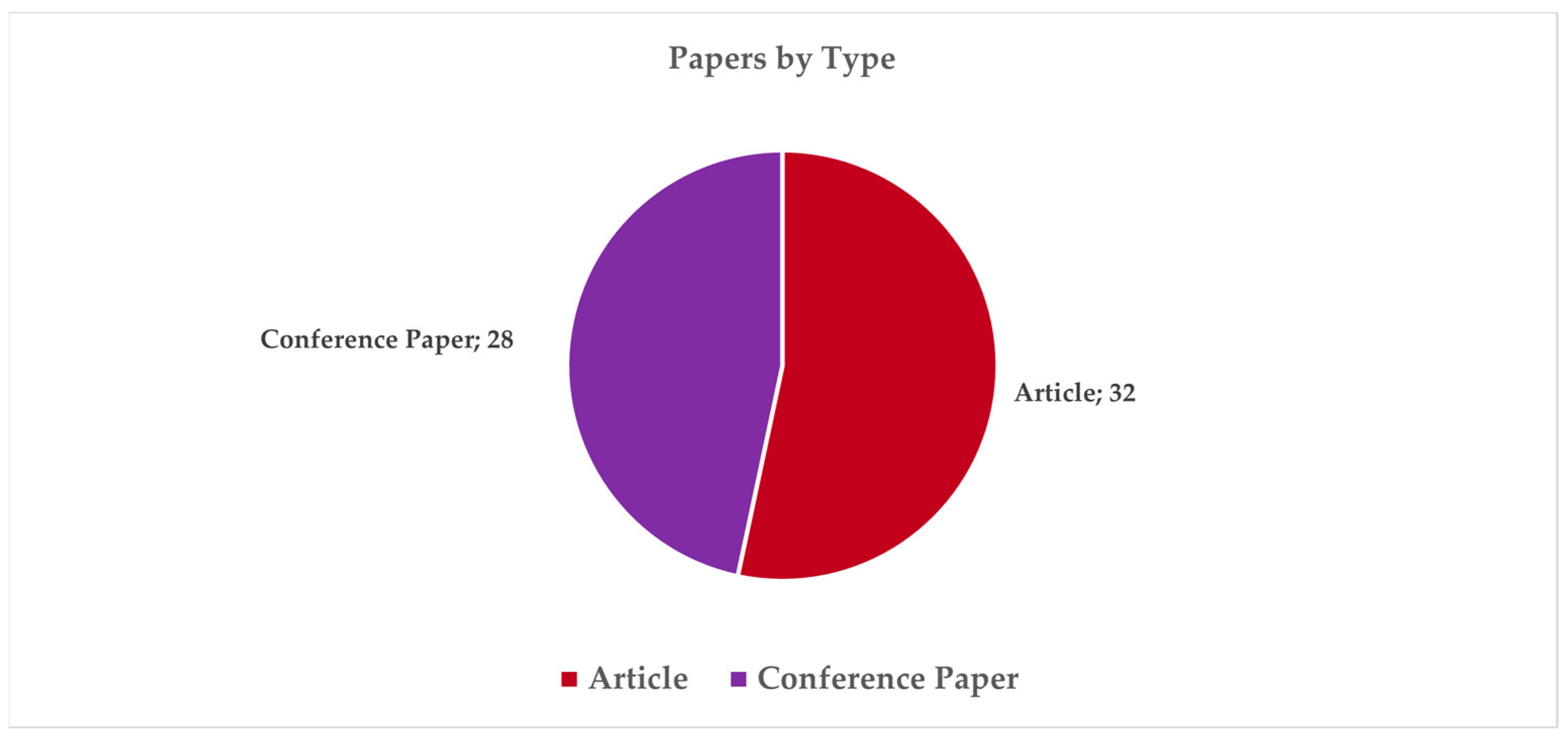
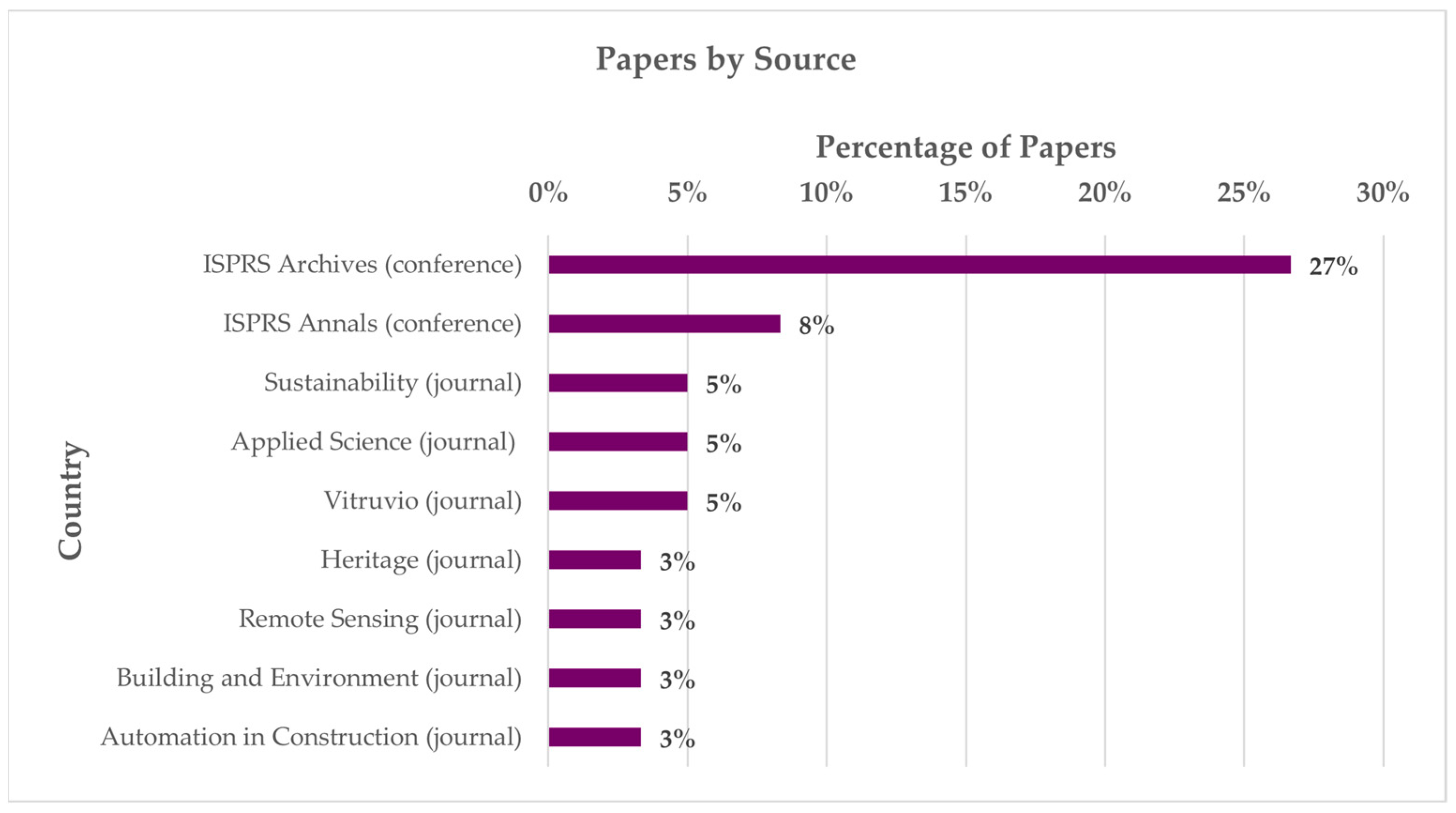

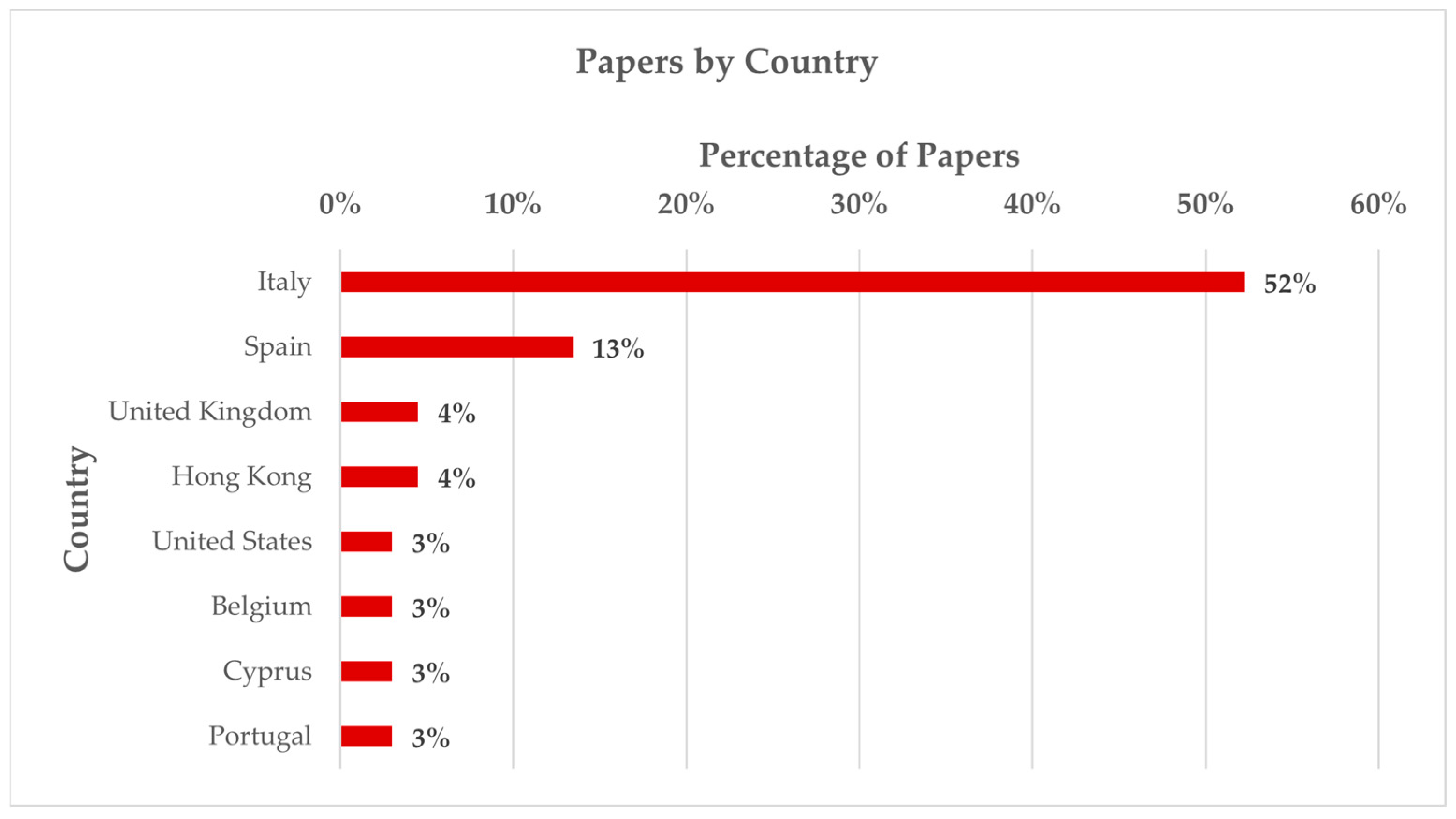
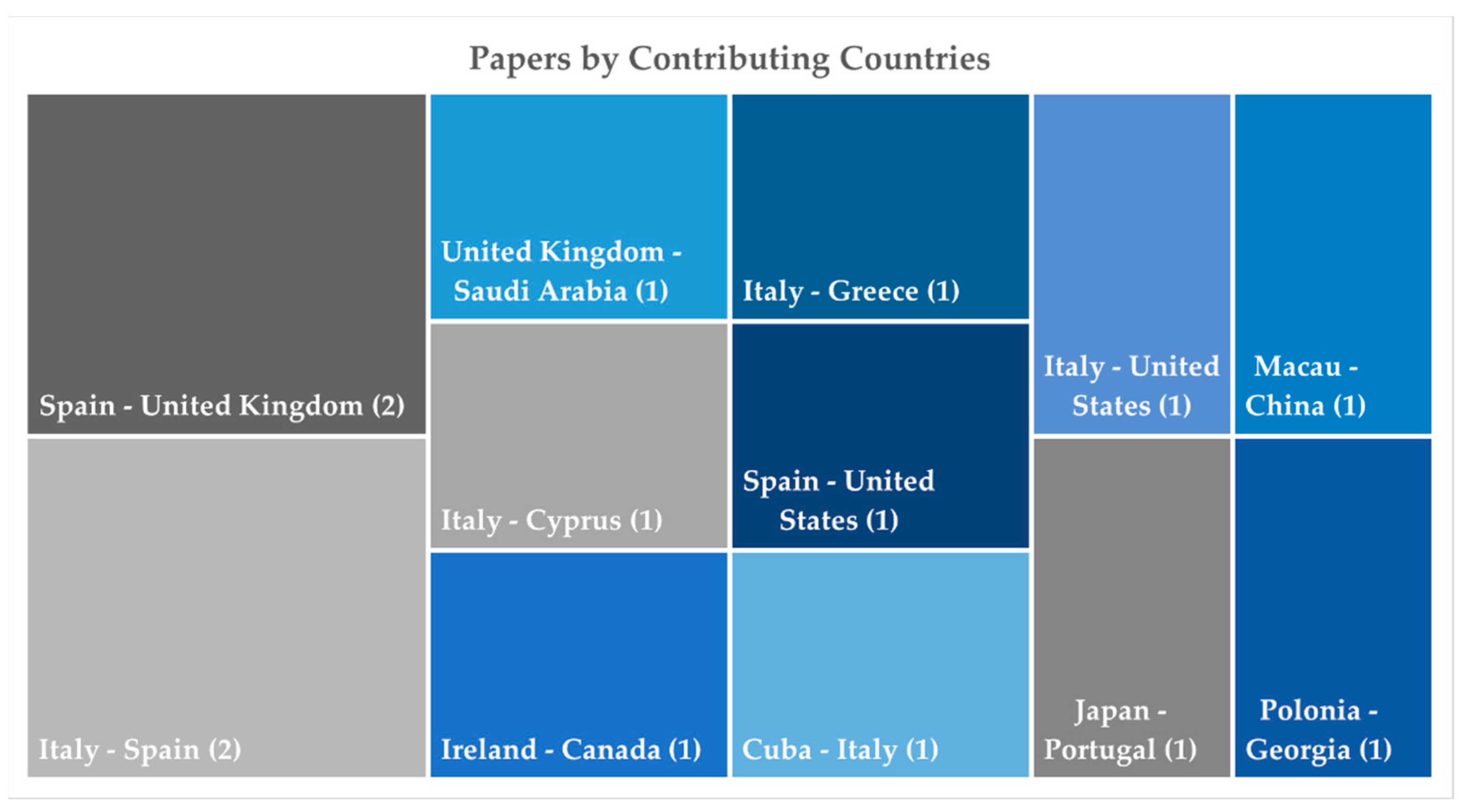

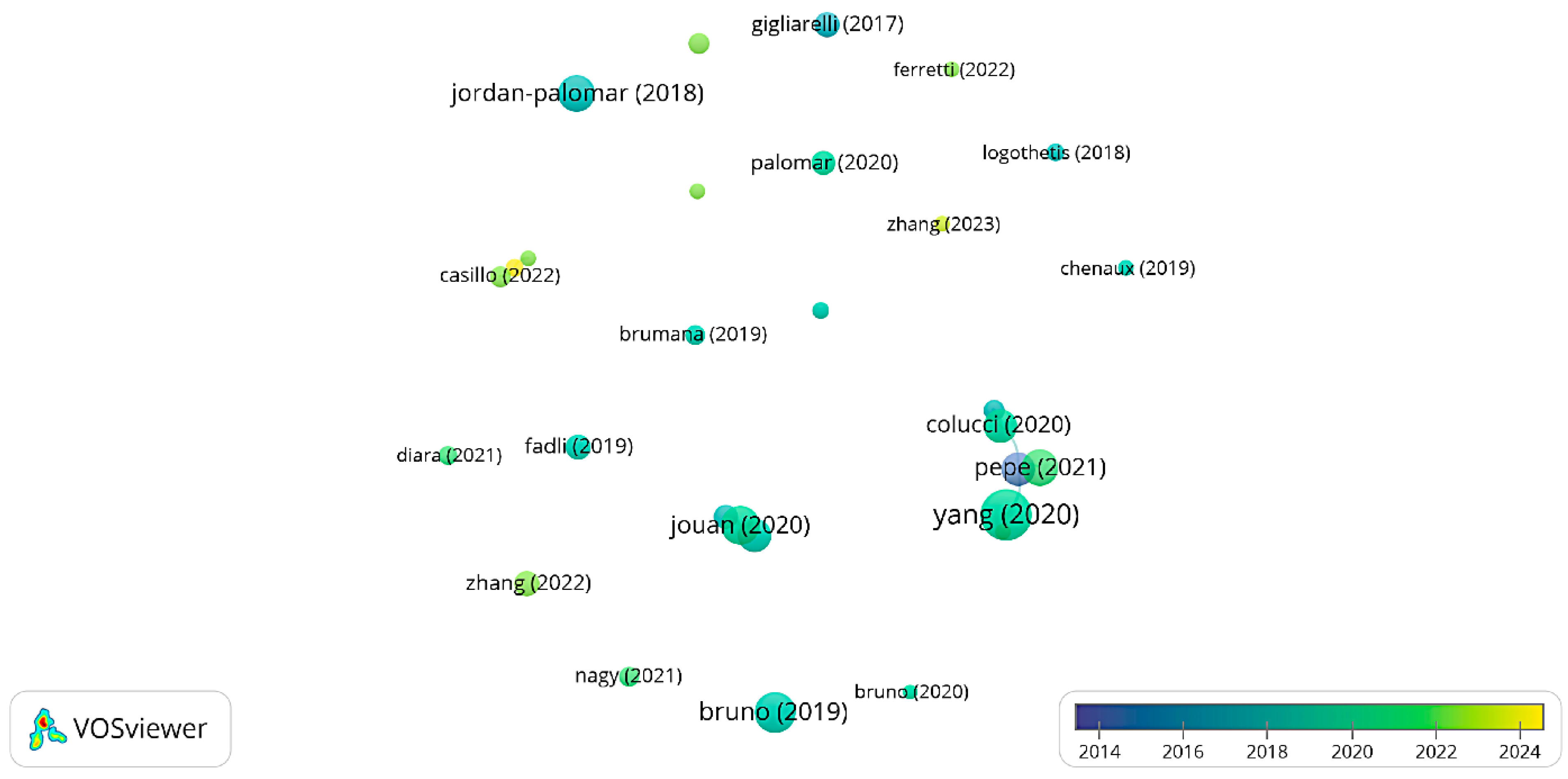
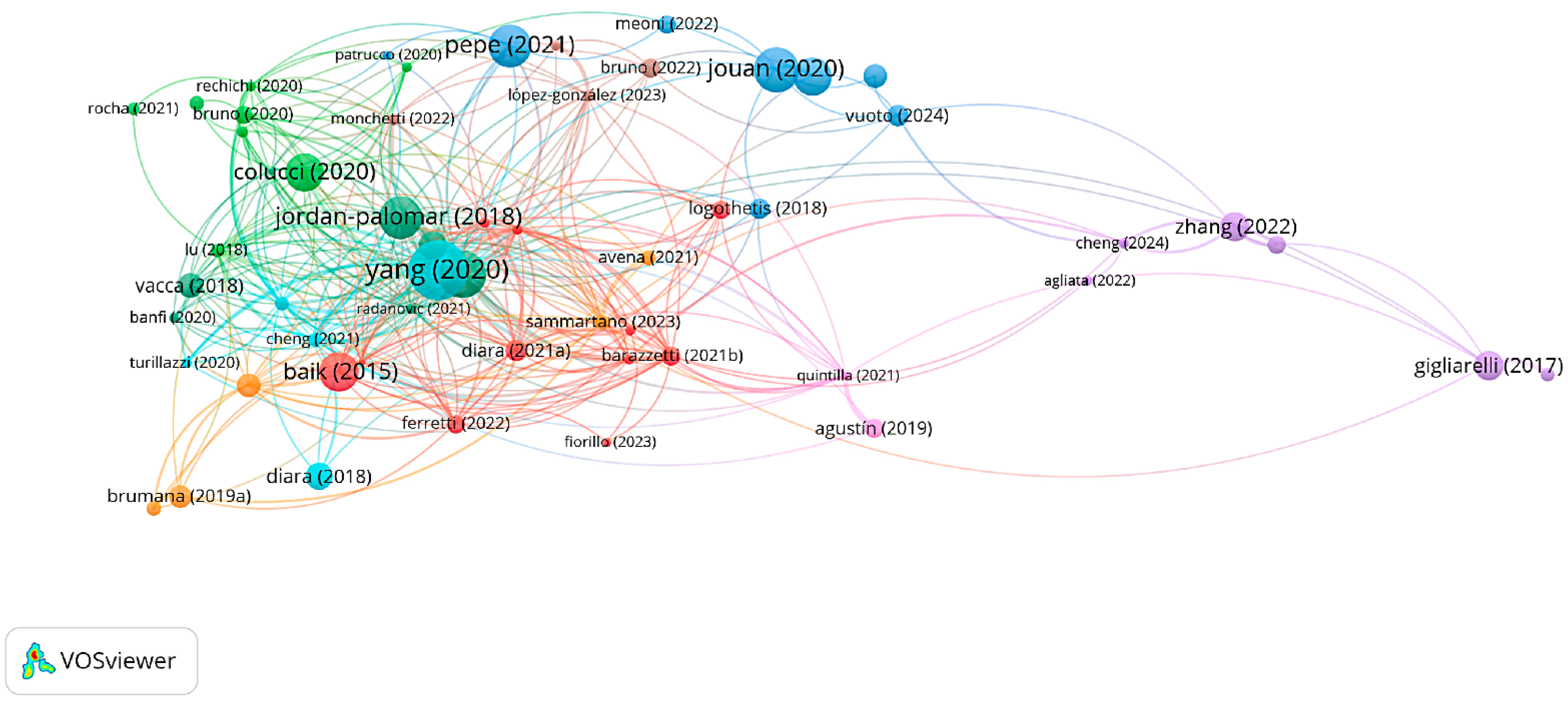
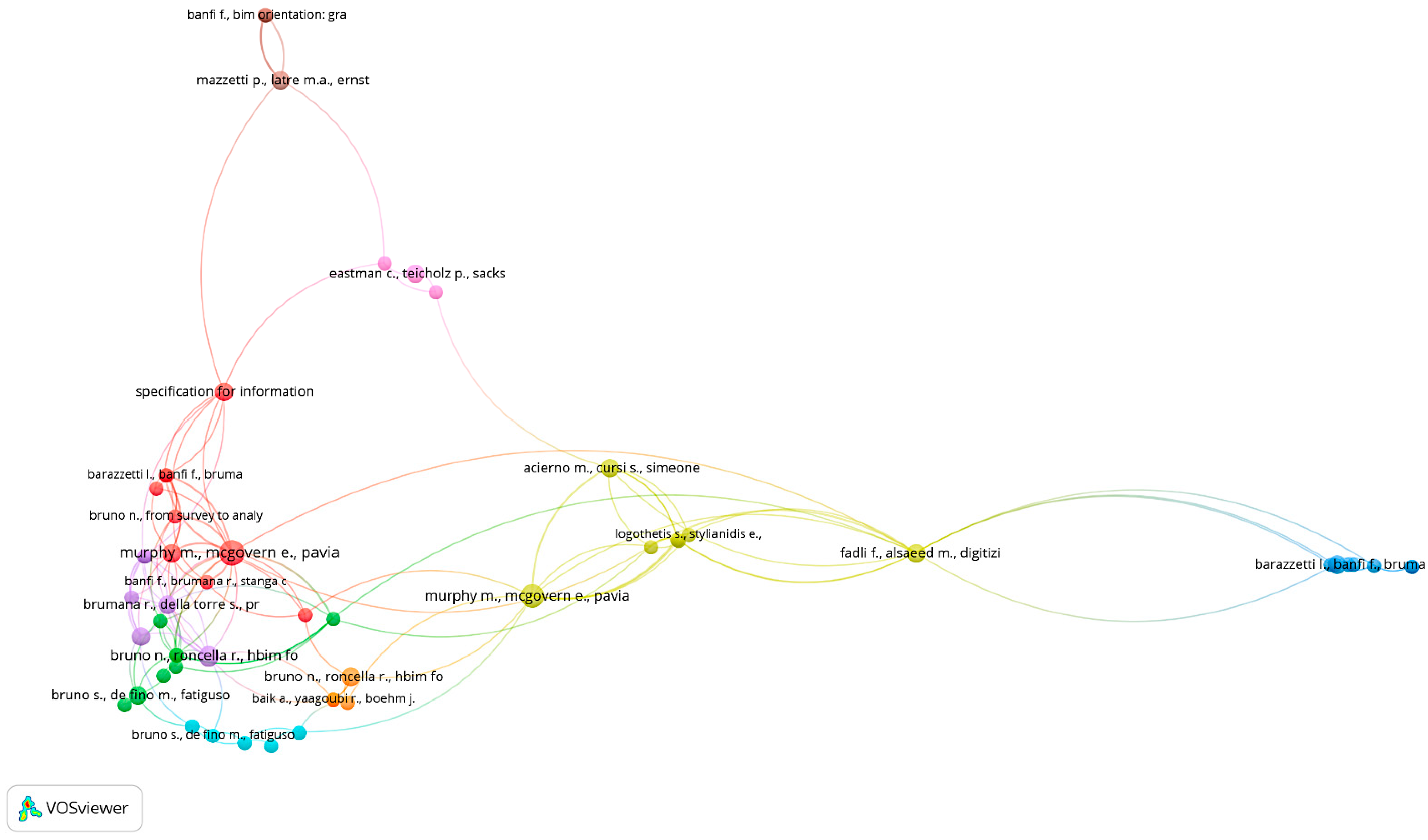

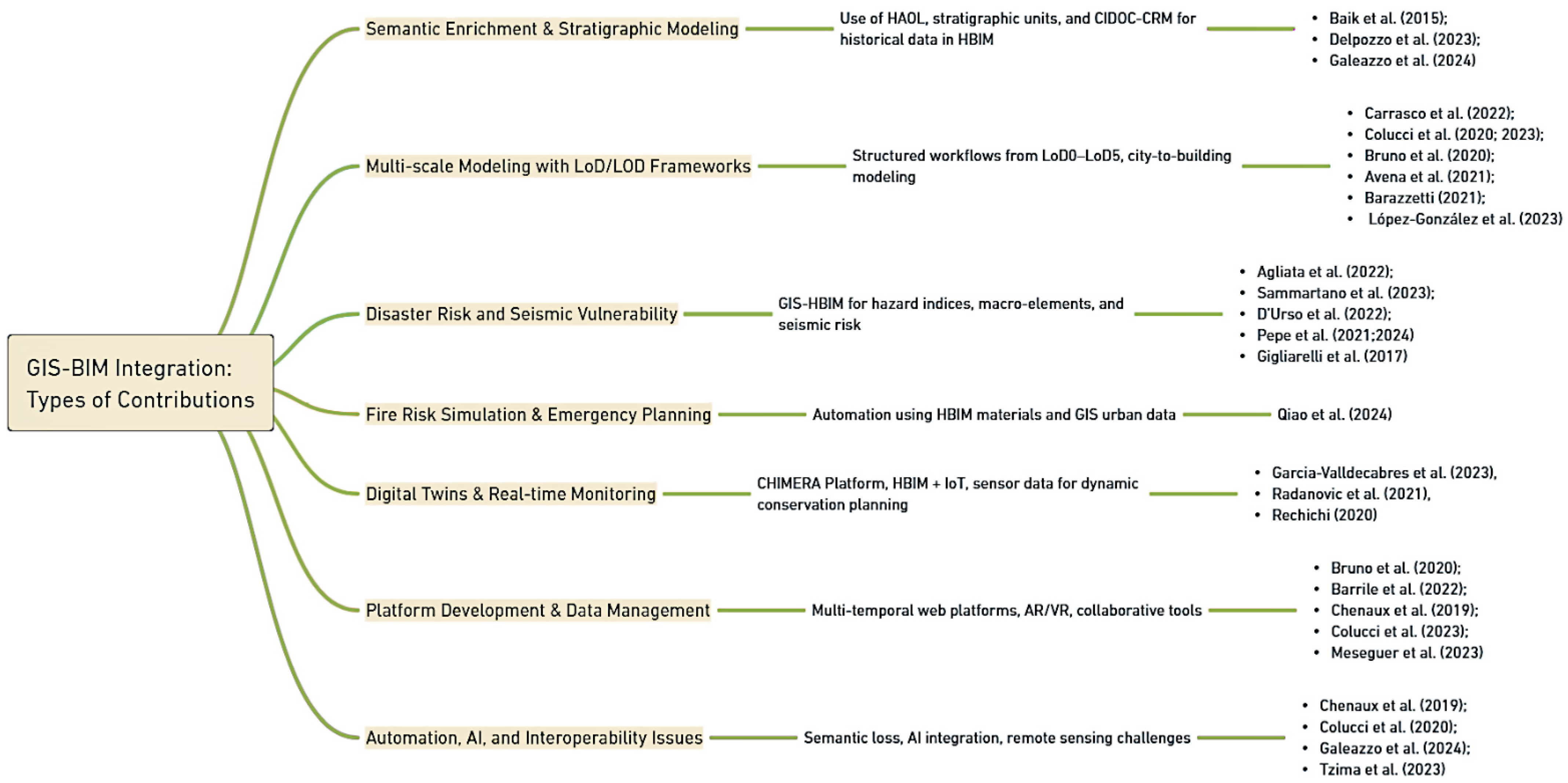
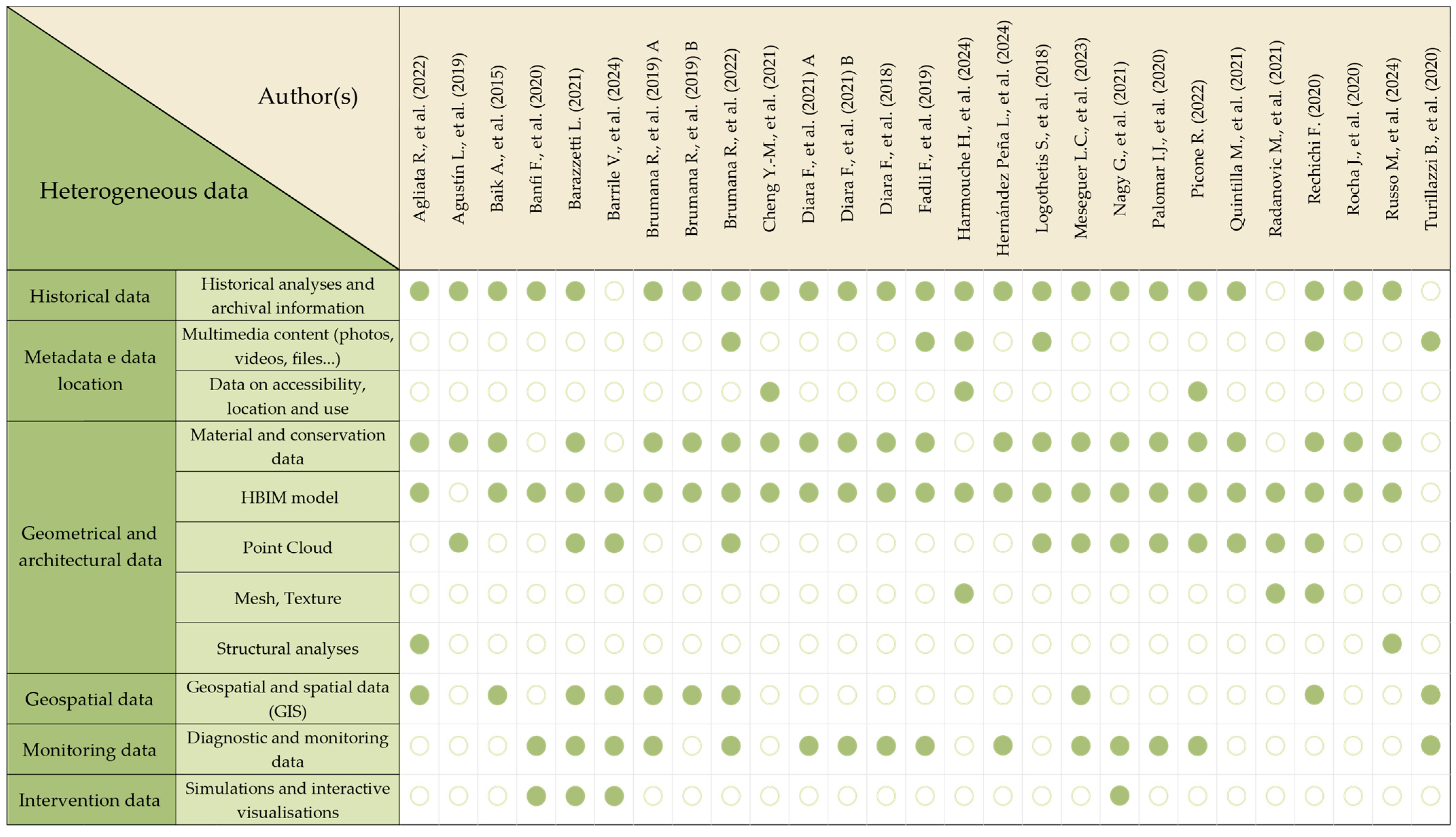
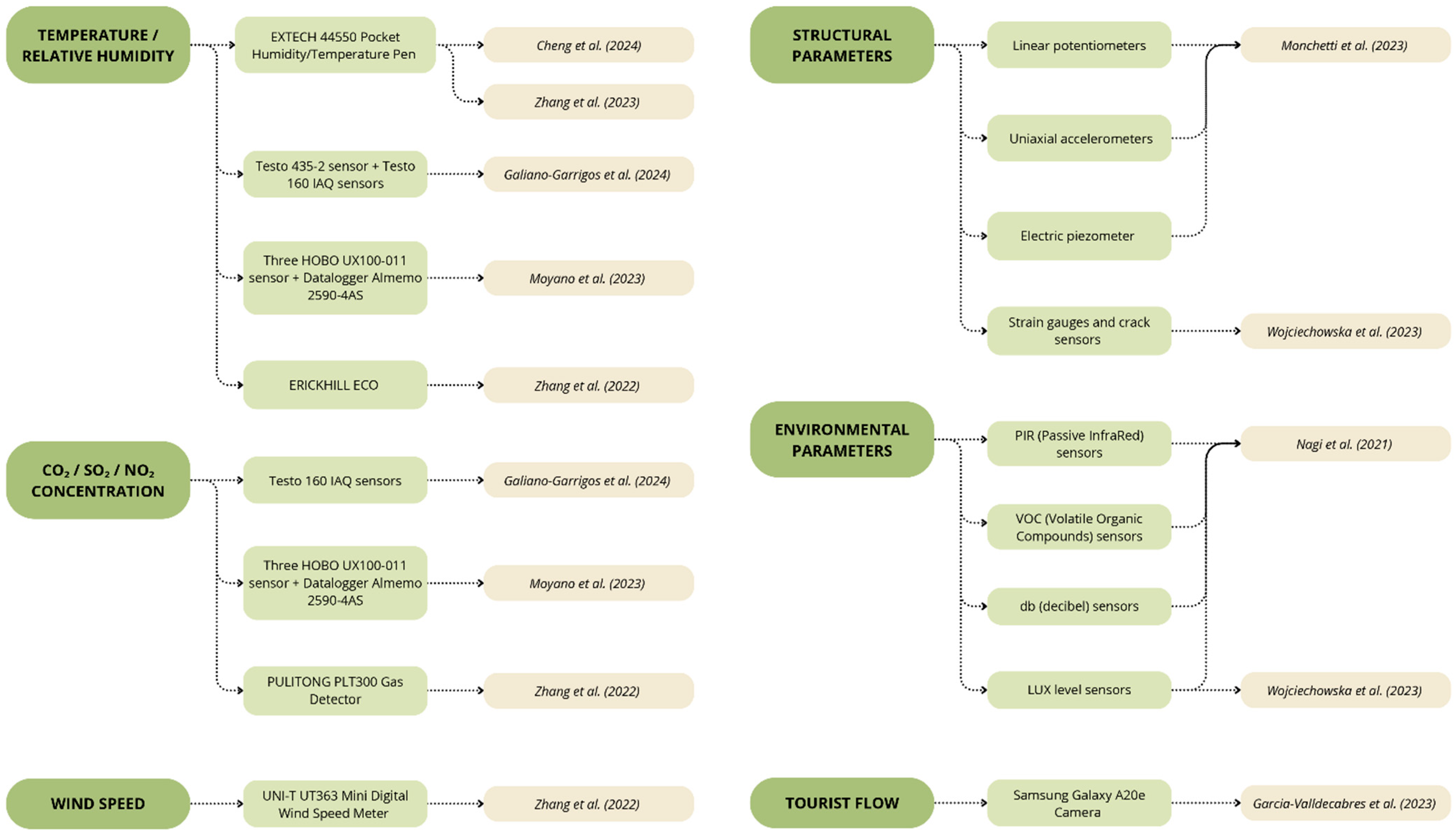
| Application Fields | Frameworks/Tools/Technologies | Authors |
|---|---|---|
| Risk assessment | TLS, IFC, HBIM-GIS integration, UAV photogrammetry, Revit | [28,29,30] |
| Diagnostic-based conservation | Revit, ArcGIS Pro, InfraWorks | [31] |
| Preventive maintenance | LoD0–LoD5 models, GIS layers, IoT | [32,33,34] |
| Archaeological reconstruction | QGIS, BlenderGIS, IFC | [35,36] |
| Heritage dissemination | Cesium, Unity 3D, Microsoft Hololens | [37,38] |
| Remote sensing and heritage monitoring | SAR, Sentinel-2, Random Forest, QGIS | [39] |
| Urban planning and sustainability | DSS, GIS-based zoning, HBIM, LiDAR, SketchUp, Revit | [40,41] |
| Temporal heritage documentation and restoration frameworks | HAOL, CityGML, Revit, CHIMERA, HBIM, GIS, IoT, cloud computing | [42,43,44] |
| Diachronic analysis | Blazegraph, CIDOC-CRM, HGIS | [45] |
| Application Fields | Frameworks/Tools/Technologies | Authors |
|---|---|---|
| 1. Recording and collation of technical, historical, and archival investigations |
| [46] |
| [47] | |
| [48,49] | |
| [50] | |
| 2. Informative management and semantic enhancement |
| [51] |
| [52] | |
| [53] | |
| [54] | |
| [34] | |
| [31] | |
| [55] | |
| [49] | |
| [42] | |
| [56] | |
| [57] | |
| [58] | |
| 3. Monitoring, management, and support for decisions |
| [59] |
| [60] | |
| [61] | |
| [44] | |
| [33] | |
| [62] | |
| 4. Digital visualization and dissemination |
| [63] |
| [64] | |
| [65] | |
| [37] |
| Application Fields | Frameworks/Tools/Technologies | Authors |
|---|---|---|
| Air quality management and energy efficiency |
| [66] |
| [41,60,67] | |
| [41] | |
| [67] | |
| [66] | |
| [68] | |
| [58] | |
| [68] | |
| [69] | |
| [41,60,68] | |
| [66] | |
| [66] | |
| [67] | |
| [41] | |
| Structural diagnostics |
| [70] |
| [71] | |
| [71] | |
| [67] | |
| [69] | |
| [70] | |
| Preventive conservation |
| [72,73] |
| [72] | |
| [73] | |
| [74,75] | |
| [74,75] | |
| [74] | |
| [73] | |
| [73] | |
| Heritage enhancement and accessibility |
| [38] |
Disclaimer/Publisher’s Note: The statements, opinions and data contained in all publications are solely those of the individual author(s) and contributor(s) and not of MDPI and/or the editor(s). MDPI and/or the editor(s) disclaim responsibility for any injury to people or property resulting from any ideas, methods, instructions or products referred to in the content. |
© 2025 by the authors. Licensee MDPI, Basel, Switzerland. This article is an open access article distributed under the terms and conditions of the Creative Commons Attribution (CC BY) license (https://creativecommons.org/licenses/by/4.0/).
Share and Cite
Fattore, C.; Buldo, M.; Priore, A.; Porcari, S.; Porcari, V.D.; De Fino, M. A Comprehensive Overview of Heritage BIM Frameworks: Platforms and Technologies Integrating Multi-Scale Analyses, Data Repositories, and Sensor Systems. Heritage 2025, 8, 247. https://doi.org/10.3390/heritage8070247
Fattore C, Buldo M, Priore A, Porcari S, Porcari VD, De Fino M. A Comprehensive Overview of Heritage BIM Frameworks: Platforms and Technologies Integrating Multi-Scale Analyses, Data Repositories, and Sensor Systems. Heritage. 2025; 8(7):247. https://doi.org/10.3390/heritage8070247
Chicago/Turabian StyleFattore, Carmen, Michele Buldo, Arcangelo Priore, Sara Porcari, Vito Domenico Porcari, and Mariella De Fino. 2025. "A Comprehensive Overview of Heritage BIM Frameworks: Platforms and Technologies Integrating Multi-Scale Analyses, Data Repositories, and Sensor Systems" Heritage 8, no. 7: 247. https://doi.org/10.3390/heritage8070247
APA StyleFattore, C., Buldo, M., Priore, A., Porcari, S., Porcari, V. D., & De Fino, M. (2025). A Comprehensive Overview of Heritage BIM Frameworks: Platforms and Technologies Integrating Multi-Scale Analyses, Data Repositories, and Sensor Systems. Heritage, 8(7), 247. https://doi.org/10.3390/heritage8070247









